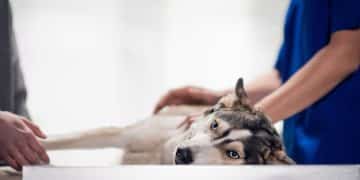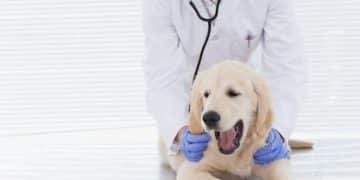Recognizing Bloat in Dogs: A Guide to Signs, Prevention, and Emergency Care
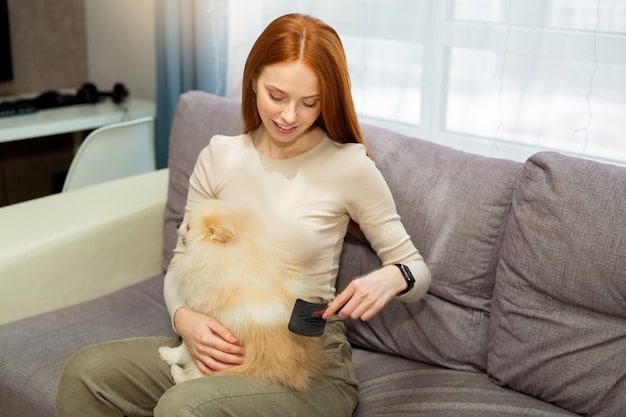
Recognizing the signs of bloat in dogs, also known as gastric dilatation-volvulus (GDV), is crucial for pet owners as it’s a life-threatening condition requiring immediate veterinary intervention; knowing the symptoms and risk factors can significantly improve your dog’s chances of survival.
As a dog owner, ensuring your furry friend’s health and well-being is always top of mind. Among the various health concerns that can affect dogs, recognizing the signs of bloat in dogs—a condition also known as gastric dilatation-volvulus (GDV)—is critical due to its rapid onset and potentially fatal consequences. This comprehensive guide will help you understand what bloat is, how to identify its symptoms, and what steps to take to ensure your dog receives timely and life-saving treatment.
Understanding Canine Bloat: What is Gastric Dilatation-Volvulus (GDV)?
Gastric Dilatation-Volvulus, commonly referred to as bloat, is a severe medical condition primarily affecting large, deep-chested dog breeds. It involves two main issues: gastric dilatation. Recognizing the early signs and understanding the underlying mechanisms of GDV are essential for any dog owner, particularly those with predisposed breeds.
What Happens During GDV?
During GDV, the stomach fills with gas, fluid, or both, causing it to expand significantly. This distension puts pressure on surrounding organs and blood vessels. The situation worsens when the distended stomach rotates or twists on its axis (volvulus), cutting off its blood supply and trapping the accumulated contents. This twisting can also obstruct blood flow to the spleen and other abdominal organs, leading to shock and potentially death if not treated promptly.
Why is Bloat Life-Threatening?
Bloat becomes life-threatening due to several factors. The distended stomach presses on the diaphragm, making it difficult for the dog to breathe. The compression of major blood vessels impairs circulation, leading to a drop in blood pressure and shock. Additionally, the lack of blood flow to the stomach wall can cause tissue death and rupture, leading to peritonitis (inflammation of the abdominal lining). The release of toxins and inflammatory substances into the bloodstream further exacerbates the condition, leading to systemic organ damage and cardiac arrhythmias. Without immediate intervention, GDV can be fatal within hours.
- Rapid Onset: GDV can develop very quickly, sometimes in a matter of hours.
- Organ Compression: The distended stomach puts pressure on the lungs, heart, and major blood vessels.
- Blood Supply Blockage: Volvulus cuts off blood flow to the stomach and other organs.
- Risk of Shock: Impaired circulation and toxin release can lead to shock and organ failure.
In conclusion, GDV is a critical veterinary emergency that requires immediate attention. Dog owners must be vigilant in recognizing the early signs and understanding the risk factors to ensure their pets receive the necessary care to survive this life-threatening condition.
Identifying the Primary Signs of Bloat in Your Dog
Prompt recognition of bloat symptoms is crucial for a positive outcome. The signs of bloat can vary, but some are more common and noticeable than others. Being familiar with these symptoms can help you react quickly and seek immediate veterinary care, potentially saving your dog’s life.
Common Physical Symptoms
One of the most apparent signs of bloat is a visibly distended or swollen abdomen. This swelling is usually most noticeable behind the rib cage. The dog may also exhibit signs of discomfort, such as restlessness, pacing, and an inability to get comfortable. They might repeatedly look at their abdomen or attempt to stretch. Additionally, unproductive retching or attempts to vomit without producing anything are common indicators of bloat.
Behavioral Changes to Watch For
Beyond physical symptoms, behavioral changes can also signal bloat. Affected dogs may become anxious, agitated, or display signs of pain. Some dogs may exhibit increased salivation or drooling, while others may show signs of weakness or collapse. Changes in breathing patterns, such as rapid or shallow breathing, can also occur as the distended stomach puts pressure on the diaphragm.
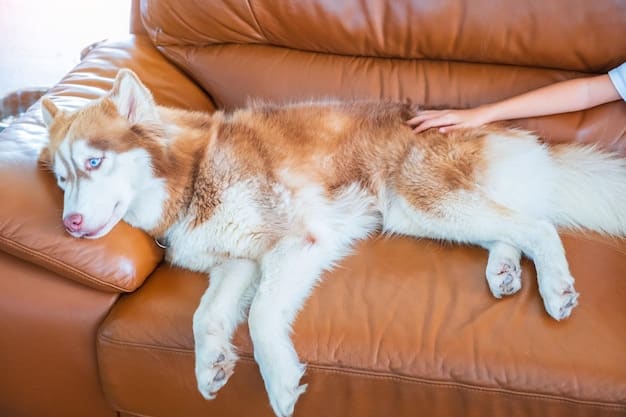
Key Symptoms Summary
- Abdominal Distension: A visibly swollen or tight abdomen, especially behind the ribs.
- Restlessness: Inability to get comfortable, pacing, and general agitation.
- Unproductive Retching: Attempts to vomit without bringing anything up.
- Increased Salivation: Excessive drooling or salivation.
- Changes in Breathing: Rapid, shallow, or labored breathing.
In summary, recognizing the symptoms of bloat involves observing both physical and behavioral changes in your dog. If you notice any of these signs, particularly in combination, it is crucial to seek immediate veterinary attention. Time is of the essence when it comes to treating bloat, and acting quickly can significantly improve your dog’s chances of survival.
Breeds at Higher Risk of Developing Bloat
While any dog can develop bloat, certain breeds are more predisposed to the condition due to their physical characteristics and genetic factors. Understanding which breeds are at higher risk can help owners take extra precautions and be more vigilant in monitoring their dogs for signs of bloat.
Large and Deep-Chested Breeds
Large and deep-chested breeds are significantly more prone to bloat. These breeds have a greater capacity for stomach distension and a conformation that may allow the stomach to twist more easily. Some of the most commonly affected breeds include Great Danes, Saint Bernards, Weimaraners, Irish Setters, and Standard Poodles. These breeds often have a higher and deeper chest which makes them more exposed to this condition.
Other Predisposing Factors
Besides breed, other factors can increase a dog’s risk of developing bloat. These include eating habits such as rapid eating or drinking, consuming large meals, and exercising immediately after eating. Stress and anxiety can also play a role in the development of bloat. Additionally, older dogs are generally more susceptible to bloat than younger ones, potentially due to decreased muscle tone and digestive efficiency.
- Eating Quickly: Dogs that gulp down their food are more likely to swallow excessive air.
- Large Meals: Feeding one large meal a day can increase the risk of bloat.
- Post-Meal Exercise: Vigorous activity after eating can contribute to stomach torsion.
- Stress and Anxiety: Anxious dogs may be more prone to digestive issues, including bloat.
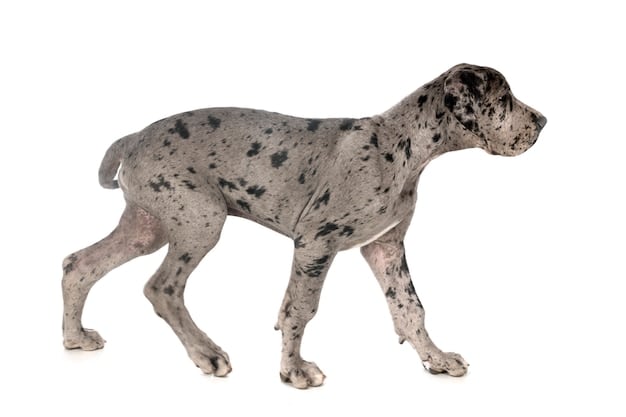
Strategies for Prevention
For dog owners of high-risk breeds, preventative measures are crucial. Feeding multiple smaller meals throughout the day instead of one large meal can help reduce the risk of bloat. Using slow-feeding bowls can prevent dogs from eating too quickly, reducing the amount of air they swallow. Avoiding strenuous exercise for at least one to two hours after meals is also recommended. Additionally, managing stress and anxiety through training, enrichment activities, and a calm environment can contribute to overall digestive health and reduce the risk of bloat. Consulting with a veterinarian about prophylactic gastropexy (surgically attaching the stomach to the abdominal wall) may also be a consideration for high-risk breeds.
In conclusion, understanding the breed-specific risks and predisposing factors for bloat is essential for proactive dog ownership. By implementing preventative strategies and being vigilant about potential symptoms, owners can significantly reduce the likelihood of their dogs developing this life-threatening condition.
Immediate Actions: What to Do If You Suspect Bloat
If you suspect your dog is experiencing bloat, time is of the essence. The condition can progress rapidly, and every minute counts when it comes to saving your dog’s life. Knowing the immediate steps to take can make a significant difference in the outcome.
Contact Your Veterinarian Immediately
The very first step is to contact your veterinarian or the nearest emergency veterinary clinic as quickly as possible. Explain the symptoms you are observing and emphasize that you suspect bloat. Informing the veterinary staff ahead of time allows them to prepare for your arrival and expedite the necessary diagnostic and treatment procedures.
Keep Your Dog Calm and Comfortable
While waiting to transport your dog to the veterinary clinic, try to keep them as calm and comfortable as possible. Minimize stress and excitement, as these can exacerbate the condition. Gently handle your dog and avoid any actions that might cause further discomfort or agitation. Providing a quiet and familiar environment can help reduce anxiety.
Avoid Home Remedies
It is crucial to avoid attempting any home remedies for bloat. Attempting to relieve the condition yourself can be dangerous and may delay necessary veterinary intervention. Do not try to induce vomiting or administer any medications without veterinary guidance, as these actions can potentially worsen the situation. This situation requires professional veterinary care and so your efforts are best spent seeking it.
- Do Not Delay: Time is critical; seek veterinary help immediately.
- Keep Calm: Minimize stress to prevent worsening the condition.
- Transport Carefully: Ensure your dog is transported safely and comfortably.
- Provide Information: Give the vet a clear and detailed account of the symptoms.
How to Safely Transport Your Dog
When transporting your dog to the veterinary clinic, ensure their safety and comfort. If possible, have someone else drive so you can focus on monitoring your dog’s condition. Position your dog in a way that minimizes pressure on their abdomen. Keeping them in a lying position, if possible, can help reduce discomfort. Alert the veterinary clinic of your imminent arrival to allow them to prepare for your dog’s immediate assessment and treatment.
In conclusion, immediate action is crucial when bloat is suspected. Contacting your veterinarian, keeping your dog calm, avoiding home remedies, and ensuring safe transport are all vital steps. By acting swiftly and decisively, you can significantly improve your dog’s chances of surviving this life-threatening condition.
Veterinary Treatment Options for Bloat
Once your dog arrives at the veterinary clinic with suspected bloat, a series of diagnostic and treatment procedures will be initiated. The primary goals of veterinary intervention are to stabilize the dog, relieve the stomach pressure, correct any twisting, and prevent recurrence.
Initial Stabilization
The first step in treating bloat involves stabilizing the dog. This typically includes placing an intravenous (IV) catheter to administer fluids and medications to combat shock and stabilize blood pressure. Oxygen therapy may also be provided to support breathing, especially if the distended stomach is compressing the lungs. The veterinary team will continuously monitor vital signs, including heart rate, respiratory rate, and blood pressure.
Decompression of the Stomach
Decompressing the stomach is a critical step in relieving bloat. This can be achieved through several methods. One common technique is passing a stomach tube down the esophagus into the stomach to release gas and fluid. In some cases, if the stomach tube cannot be passed due to twisting, a trocarization may be performed. Trocarization involves inserting a needle through the abdominal wall directly into the stomach to release the built-up pressure. Either one of these methods should provide some much needed relief.
Surgical Intervention (Gastropexy)
Surgical intervention is often necessary to correct the stomach twisting (volvulus) and prevent future episodes. The most common surgical procedure is a gastropexy, which involves attaching the stomach to the abdominal wall to prevent it from twisting again. During surgery, the veterinarian will also assess the stomach and spleen for any damage and address any complications, such as tissue necrosis or rupture.
- Fluid Therapy: IV fluids to combat shock and maintain blood pressure.
- Stomach Decompression: Relieving pressure via stomach tube or trocarization.
- Gastropexy: Surgically attaching the stomach to prevent future twisting.
- Monitoring: Continuous monitoring of vital signs during and after treatment.
Post-Operative Care
After surgery, close monitoring and post-operative care are essential. This includes pain management, continued fluid therapy, and administration of antibiotics to prevent infection. The dog will be kept under close observation for several days to monitor for any complications, such as arrhythmias or peritonitis. Gradual reintroduction of food and water will be implemented, along with medications to promote gastrointestinal motility and prevent nausea.
In conclusion, veterinary treatment for bloat involves a multi-faceted approach, including stabilization, decompression, surgical intervention, and comprehensive post-operative care. Prompt and aggressive treatment is crucial for improving the chances of a successful outcome and preventing recurrence of this life-threatening condition.
Preventative Measures: Reducing the Risk of Bloat
While bloat can be a frightening condition, there are several preventative measures that dog owners can take to reduce the risk, particularly for predisposed breeds. Implementing these strategies can contribute to your dog’s long-term health and well-being.
Dietary Management
Proper dietary management plays a significant role in preventing bloat. Feeding your dog multiple smaller meals throughout the day instead of one large meal can help reduce the risk of stomach distension. Choose high-quality dog food that is appropriate for your dog’s age, breed, and activity level. Avoid foods that contain excessive amounts of fermentable carbohydrates, as these can contribute to gas production. Consider using slow-feeding bowls or puzzle feeders to prevent your dog from eating too quickly.
Feeding Practices
In addition to dietary choices, feeding practices are also important. Avoid raising your dog’s food bowl, as this can increase the amount of air swallowed during eating. Ensure that fresh water is always available, but limit water intake immediately after meals, as excessive drinking can contribute to stomach distension. Avoid feeding your dog immediately before or after strenuous exercise. Instead, allow at least one to two hours of rest before and after meals.
Prophylactic Gastropexy
For dog breeds at high risk of developing bloat, prophylactic gastropexy may be a consideration. This surgical procedure involves attaching the stomach to the abdominal wall to prevent it from twisting in the future. Prophylactic gastropexy can be performed during routine spay or neuter surgeries, providing a preemptive measure against bloat. Discuss this option with your veterinarian to determine if it is appropriate for your dog.
- Multiple Small Meals: Feeding several smaller meals to reduce stomach distension.
- Slow Feeding: Using slow-feeding bowls to prevent rapid eating and air swallowing.
- Rest After Meals: Avoiding strenuous exercise for one to two hours after eating.
- Prophylactic Gastropexy: Surgical prevention for high-risk breeds.
Stress Reduction
Managing stress and anxiety can also contribute to preventing bloat. Provide a calm and stable environment for your dog. Ensure they have plenty of opportunities for exercise, mental stimulation, and social interaction. Address any underlying behavioral issues that may contribute to stress, such as separation anxiety or noise phobias. Consider using calming aids, such as pheromone diffusers or supplements, if necessary.
In conclusion, preventative measures are key to reducing the risk of bloat in dogs. By implementing proper dietary management, following appropriate feeding practices, considering prophylactic gastropexy, and managing stress, dog owners can significantly decrease the likelihood of their pets developing this life-threatening condition.
| Key Point | Brief Description |
|---|---|
| 🚨 Recognizing Signs | Immediate recognition of bloat symptoms is critical for a positive outcome. |
| 🏥 Prompt Veterinary Care | Contact your vet immediately if you suspect bloat. Time is of the essence. |
| 🍽️ Dietary Management | Feed smaller, more frequent meals to reduce the risk of bloat. |
| 🐾 Prophylactic Gastropexy | Consider gastropexy for high-risk breeds to prevent stomach twisting. |
Frequently Asked Questions (FAQ)
▼
The exact cause of bloat is not fully understood, but it often involves the stomach filling with gas, food, or fluid, and then twisting. Factors like breed, eating habits, and stress can contribute.
▼
Bloat can be fatal within hours if left untreated. The rapid progression of the condition can lead to shock, organ damage, and ultimately, death. Immediate veterinary intervention is crucial.
▼
Yes, large and deep-chested breeds like Great Danes, Saint Bernards, and Weimaraners are more prone to bloat due to their body structure and genetic predispositions.
▼
Key signs include a distended abdomen, restlessness, unproductive retching, increased salivation, and changes in breathing. If you notice these, seek veterinary care immediately.
▼
While not always preventable, you can reduce the risk by feeding smaller, more frequent meals, using slow-feeding bowls, avoiding exercise after meals, and considering gastropexy for high-risk breeds.
Conclusion
In conclusion, recognizing the signs of bloat in dogs and acting quickly are paramount for saving your pet’s life. By understanding the risk factors, identifying the symptoms, and implementing preventative measures, you can significantly improve your dog’s chances of avoiding this life-threatening condition. Always consult with your veterinarian for personalized advice and care.
